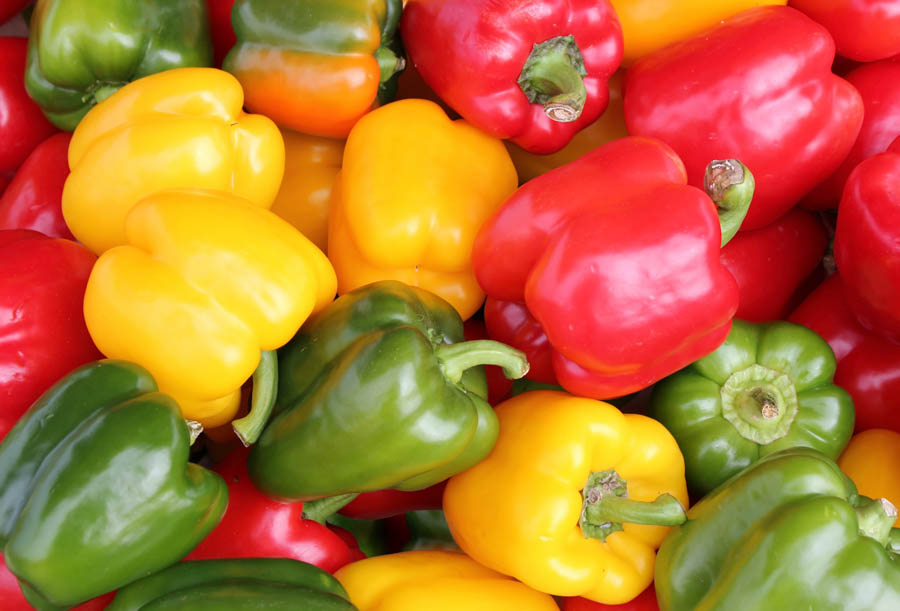Sweet Pepper Varieties: Colors, Flavors and Growing Characteristics

When many gardeners in North America think sweet pepper, they think of the large, bell-type Emerald green sweet pepper with a slightly grassy flavor. Fortunately, all sweet peppers aren’t green: today’s gardeners have access to a wide array of sweet peppers, both bell and non-bell types, in a range of colors, sizes and shapes.
Gardeners are more likely to be successful with non-bell type sweet peppers. Non-bell types produce pepper fruits in a wider range of shapes and colors and with greater sweetness and productivity than classic bell types.
For beginning gardeners or those who have not previously grown sweet peppers, GardenZeus recommends Carmen, An All American Selections winning hybrid, producing long, curved red pepper fruits and strong, sweet flavor. It can be roasted or fried, produces heavy yields and provides good sunburn protection.
The long-time favorite heirloom Sweet Banana is an ideal sweet pepper for the California home garden; it is a prolific producer of long, slender green to yellow to orange to red long fruits that are tasty raw, fried, grilled, or made into jam or relish.
Grow the “pimento” in the olive! Heirloom Sheepnose Pimento peppers produce large 4 inch by 3 inch rounded red peppers that are sweet, meaty and good for using fresh or canned.
Avid cooks may want to grow one of the many excellent open-pollinated and heirloom sweet peppers used in Italian cooking: Italian Pepperoncini (traditional Italian pickling pepper), Golden Marconi (classic Italian multipurpose pepper), Jimmy Nardello, (traditional frying pepper), and Corno di Toro (multipurpose pepper).
For those gardeners with some experience growing sweet peppers, there are a number of bell-type peppers from which to choose. There are many options in the green ripening to red bell type category. GardenZeus recommends Gypsy as a reliable hybrid producing wedge-shaped bell fruits on a plant resistant to Tobacco Mosaic virus. Slightly more challenging are two open-pollinated varieties: Yolo Wonder, thought to be an improvement on California Wonder with good sunscald and resistance to Tobacco Mosaic Virus, and Jupiter, an older, but reliable commercial variety with good disease resistance.
Orange and yellow bell pepper types often produce the largest and most uniform fruits, although they mature later, are more prone to sun scald, require more fertility, and produce fewer fruits per plant. GardenZeus recommends two open-pollinated orange peppers: Orange Sun and Gourmet.
Avid cooks will be interested in the open-pollinated Purple Beauty (deep purple) or the heirloom Chocolate Beauty (dark brown) more for the unusual color they add to a dish than for their very mild flavor. Want many colors all at once? The open-pollinated Iko-Iko produces bell shaped fruits in yellow, purple, orange and red all at the same time as the fruits move through various stages of maturity.
Advanced gardeners who have had prior success with bell-type sweet peppers should consider the California Wonder heirloom group: California Wonder (green to red), Golden CalWonder (large gold fruits) and California Wonder Orange. Gardeners who are willing to provide these plants with exceptionally fertile soil and grow a large canopy early in the growing season will be rewarded with exceptional pepper fruits.
Smaller sweet pepper varieties, also called “lunchbox” peppers, produce incredibly sweet peppers in a variety of colors that can be eaten fresh or cooked. For a lunchbox variety, try Sweet Cherry Blend, an heirloom plant producing cherry-tomato-sized yellow and red fruits and Pretty and Sweet, the 2015 All-American Selection winning hybrid, an ornamental plant with sweet peppers that taste as good as they look. Both are excellent in containers.